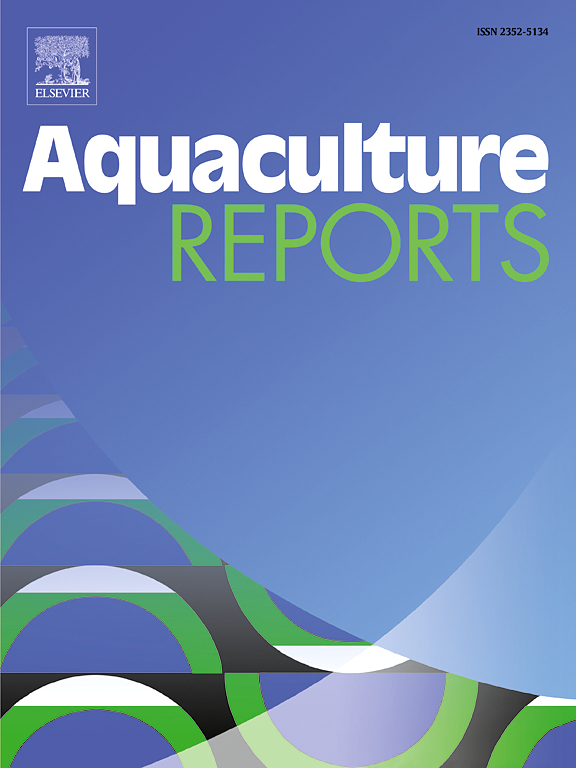Feeding value of low opportunity cost biomasses (agri-food by-products) for development of circular pond fish feeds: An evaluation with common carp (Cyprinus carpio)
IF 3.2
2区 农林科学
Q1 FISHERIES
引用次数: 0
Abstract
In many cases, prior to their inclusion in feed, food system by-products need some sort of refinement. Many options are being explored on how these by-products could aid in direct re-generation of food with the shortest value chain. In this study, we hypothesized that common carp raised semi-intensively in European fishponds could convert waste resources to food directly. The 30 % ingredient replacement method was used to evaluate the digestibility of 12 local waste resources of plant origin as candidates for ‘circular feed ingredients’ for feeding pond fish. It was evident from the results that protein digestion (>70 %) is not an issue, even showing similarities between pre-treated resources (brewery wastes) and non-pre-treated resources (oilseed expellers or legumes) – but lysine or methionine decide from 20 % – 49 % utilization of digested protein from those ingredients. It is therefore, recommended that complementary combination of ingredients be explored to overcome limiting DIAAS in natural food base in ponds. In this case, rapeseed expeller and barley distillers’ grain seem to be closest candidates to fix the lysine and methionine limitation in natural pond food base. Microbial/enzymatic/mechanical pre-processed ingredients such as extract of sugar beet, brewery wastes, bakery or extruded breakfast cereals have low pollution potential (P bioavailability 50–80 %) – contrary to proteinaceous resources (oilseed expellers or broken legumes) which had P bioavailability ≤ 25 % (except pea). Bakery or breakfast cereals discards are novel sources of digestible energy for pond fish (∼400 kcal 100 g−1). Given that NDF:ADF ratio (>2:1) allow for easy fermentation in gut, besides possibly laced with microbial enzymes or some pre-hydrolysis, the undigested fibers in sugar beet, legumes, or oilseed expeller (AD carbohydrate 1–20 %) could boost pond food web through microbial upcycling. This study highlights the possibility of developing circular, less-refined semi-intensive pond fish feeds “commercially”. Such feed could enhance resource use efficiency at food-system level.
低机会成本生物质(农业食品副产品)在开发循环池塘鱼类饲料中的投喂价值:以鲤鱼为例的评价
在许多情况下,在加入饲料之前,食品系统的副产品需要进行某种精制。关于如何利用这些副产品帮助以最短的价值链直接再生食品,人们正在探索许多选择。在这项研究中,我们假设在欧洲鱼池中半集约化养殖的普通鲤鱼可以将废物资源直接转化为食物。采用30% %的原料替代法,对12种当地植物源废弃资源作为“循环饲料原料”的候选饲料进行消化率评价。从结果中可以明显看出,蛋白质消化(>70 %)不是一个问题,甚至显示了预处理资源(啤酒厂废物)和未预处理资源(油籽提取物或豆类)之间的相似性-但赖氨酸或蛋氨酸决定了从这些成分中消化蛋白质的利用率为20% % - 49% %。因此,建议探索各成分的互补组合,以克服池塘天然食品基质中DIAAS的局限性。在这种情况下,油菜籽和大麦酒糟似乎是最接近的候选人来解决赖氨酸和蛋氨酸在天然池塘食物基地的限制。微生物/酶/机械预处理成分,如甜菜提取物、啤酒废料、烘焙或挤压早餐谷物,具有低污染潜力(磷生物利用度50-80 %),而蛋白质资源(油籽提取物或碎豆科植物)的磷生物利用度≤ 25 %(豌豆除外)。烘焙或早餐谷物废料是池塘鱼可消化能量的新来源(~ 400 kcal 100 g−1)。考虑到NDF:ADF比例(2:1)允许在肠道中容易发酵,除了可能添加微生物酶或一些预水解外,甜菜、豆类或油籽中未消化的纤维(AD碳水化合物1-20 %)可以通过微生物升级循环来促进池塘食物网。这项研究强调了“商业化”开发循环、精制程度较低的半集约化池塘鱼类饲料的可能性。这种饲料可以提高粮食系统层面的资源利用效率。
本文章由计算机程序翻译,如有差异,请以英文原文为准。
求助全文
约1分钟内获得全文
求助全文
来源期刊

Aquaculture Reports
Agricultural and Biological Sciences-Animal Science and Zoology
CiteScore
5.90
自引率
8.10%
发文量
469
审稿时长
77 days
期刊介绍:
Aquaculture Reports will publish original research papers and reviews documenting outstanding science with a regional context and focus, answering the need for high quality information on novel species, systems and regions in emerging areas of aquaculture research and development, such as integrated multi-trophic aquaculture, urban aquaculture, ornamental, unfed aquaculture, offshore aquaculture and others. Papers having industry research as priority and encompassing product development research or current industry practice are encouraged.
 求助内容:
求助内容: 应助结果提醒方式:
应助结果提醒方式:


